|
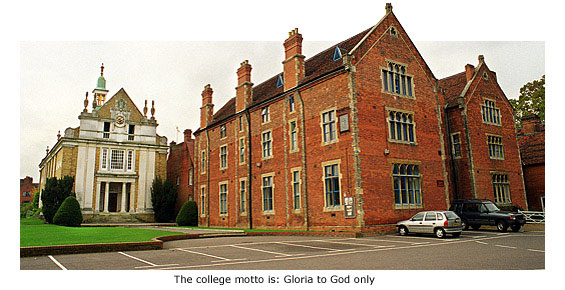
Standing on high ground just before Maze Green Road is College Lodge, a small, mock-Tudor style house built in 1924 that overlooks the large and impressive frontage of Bishop’s Stortford College – founded as a school in 1868 but not called a college until 1901. The first school on this site was the nonconformist Bishop’s Stortford Collegiate School, started in 1850 as an alternative to the town’s former, and predominantly Anglican, Grammar school.
Shortly after Rev Francis Rhodes became vicar of St Michael’s in 1849, he was approached by Rev W A Hurndall of the Congregational church in Water Lane (See Guide 6) for help in starting a non-sectarian propriety school. A propriety school was run by a group of owners acting as a registered company. Rhodes, however, was far more interested in reviving the town’s old Grammar school to its former status, and when he elected not to help with the task Hurndall went ahead with his plan regardless. The following year a non-sectarian collegiate school was formed and opened in a house called the Manse in Water Lane. Its success was immediate and in 1852 the school moved to a much larger building on the present site of the college.
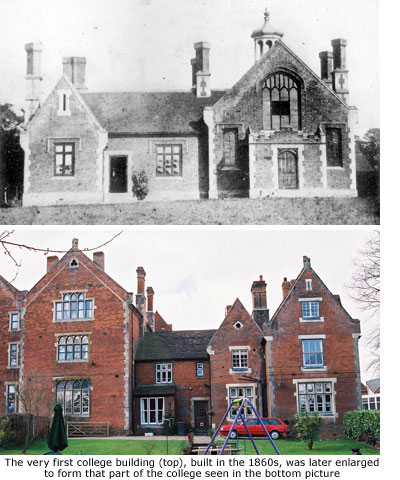 In 1866 a group of prominent Nonconformists in East Anglia formed a committee to establish a public school ‘in which Evangelical Nonconformists might secure for their boys an effective and Christian education on terms that should not be beyond the reach of the middle class generally’. In 1866 a group of prominent Nonconformists in East Anglia formed a committee to establish a public school ‘in which Evangelical Nonconformists might secure for their boys an effective and Christian education on terms that should not be beyond the reach of the middle class generally’.
Shortly after, an approach was made to the committee of the Bishop’s Stortford Collegiate school and terms for acquisition of the school buildings on this site were arranged. On 31 May 1867 the East of England Nonconformists Schools Association Ltd was incorporated and the first purpose built school building – designed in the Gothic style by J Clark FSA – was erected here.
The headmaster of the collegiate school had been Joseph Bell, but when he resigned in October 1867 to take up a post in Yorkshire the directors advertised the vacant position. A shortlist of applicants was decided by ballot and in February 1868 the Rev Richard Alliott, a 29 year-old Cambridge Classical graduate and former Congregational minister from Cheshire, with no teaching experience, was appointed. He took up his position on 1 September that same year, and on the 23rd of that month the school was formally inaugurated under the name of Nonconformist Grammar School.
The school opened with just forty boys but by 1878 that number had increased to over one hundred and thirty. Rev Alliott led the school for 31 years and when he died in 1899 was succeeded the following year by Francis Samuel Young, a former pupil of the school who had taken a science degree at Queen’s College Oxford.
Mr Young made his mark immediately. Having two Grammar schools in the town had led to much public confusion, so he persuaded the governors to change the name of the school to Bishop’s Stortford College. He was also instrumental in designing the present college shield (never officially 'granted' or registered), and changed the name of the Nonconformist Grammar school magazine to Stortfordian – renamed Old Stortfordian in 1919. He also succeeded in getting the constitution of the school changed in 1904. The Nonconformist Schools Association was wound up and the Chairman of the Directorate became the Chairman of the Governing Council of the College. This included among its members representatives of the Congregational, Baptist, and Presbyterian Churches.
Between 1900 and 1914 Mr Young built up the school’s reputation as one of the smaller English public schools, and in 1909 was elected a member of the Headmasters’ Conference. Under his headmastership, extensive new playing fields were acquired and many new buildings erected including boarding houses and a preparatory school.
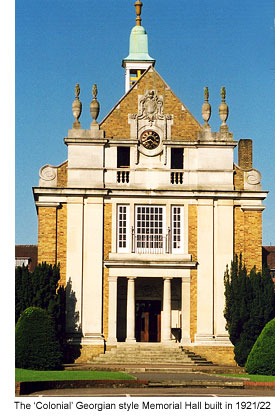 In the First World War, 600 former students of the college served their country, sixty-two of whom made the supreme sacrifice. To their memory Mr Young instigated the building of the Memorial Hall in 1921/22, designed in a ‘Colonial’ Georgian style by architect, Clough Williams Ellis. At that time nobody could have dreamed it possible that the Roll of Honour at the hall's entrance would be joined by a second Roll of Honour in 1949, inscribed with the names of a further 154 former students who lost their lives in World War II. In the First World War, 600 former students of the college served their country, sixty-two of whom made the supreme sacrifice. To their memory Mr Young instigated the building of the Memorial Hall in 1921/22, designed in a ‘Colonial’ Georgian style by architect, Clough Williams Ellis. At that time nobody could have dreamed it possible that the Roll of Honour at the hall's entrance would be joined by a second Roll of Honour in 1949, inscribed with the names of a further 154 former students who lost their lives in World War II.
The interior of the Memorial Hall was later remodelled but still combined a chapel, concert hall and theatre, fulfilling the role it was originally designed for.
In 1926 the College purchased Westfield House for use as a sanatorium. Situated between Maze Green Road and Hadham Road, and once owned by Charles Gold junior, it fulfilled the role it was bought for until 1968 when a new sanitorium was built nearby. Reorganisation of school Day Houses then led to Westfield House being renamed Sutton House in memory of a former long-serving mathematics master. The building is currently shared with Benson House, but its appearance has since been marred by modern additions to the structure.
The rise in academic standards of the school under Mr Young was reminiscent of the town’s Grammar school in the 17th century under headmasters’ Leigh and Tooke, and an increasing number of awards were gained at Oxford and Cambridge. The college was also becoming well known in the sporting world at this time, especially for its prowess in swimming. This was largely due to headmaster Rev Alliot, who in 1895 instigated the building of an indoor swimming pool. Costing £5,000, and heated all year round, it was one of only two such pools in the country at that time. An outdoor pool was built in 1928 and both were still in use until the year 2001.
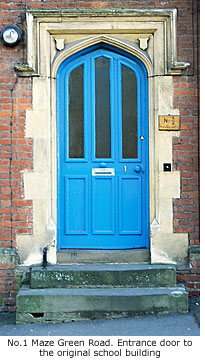 When Mr Young retired as headmaster in 1931 the reputation of the College had been well and truly established. Under him the number of entrants had risen to 350 and the Grammar school in Hadham Road, no longer able to compete, finally closed its doors and amalgamated with the college at around the same time as his retirement. He then took a curacy at Church Stretton in Shropshire but when ill health forced him to quit soon after, he returned to nearby Sawbridgeworth where he died on 2 September 1934. The library, built in 1932, was opened by his wife in 1936 and named the Young Memorial Library.
When Mr Young retired as headmaster in 1931 the reputation of the College had been well and truly established. Under him the number of entrants had risen to 350 and the Grammar school in Hadham Road, no longer able to compete, finally closed its doors and amalgamated with the college at around the same time as his retirement. He then took a curacy at Church Stretton in Shropshire but when ill health forced him to quit soon after, he returned to nearby Sawbridgeworth where he died on 2 September 1934. The library, built in 1932, was opened by his wife in 1936 and named the Young Memorial Library.
Many former pupils have gone on to make their name in the world in all manner of professions, but the college must be unique in having produced seven high ranking officials in Britain's Intelligence Service, including three Director Generals of MI5.
MI5 is the security service responsible for protecting the UK against threats to national security. Founded in 1909 (as the Secret Service Bureau) it has had, to date (2008), fifteen Director Generals of whom three were former students at Bishop's Stortford College. The college is certainly not a covert breeding ground for the nation's intelligence service, but no less than seven high-ranking members of the intelligence service have passed through its doors as students or teachers.
Sir Dick White (1906–1993) joined the service in 1936 and during World War II was closely involved in the highly successful 'Double Cross' system against the Nazis. He became Director General in 1953 but in 1956 moved to the Secret Intelligence Service (also known as MI6) to become its chief. There he remained until his retirement in 1972 and remains the only person to have headed both organisations successively.
Brendan Bracken (1901 – 1958) was a prep and junior school teacher at the college in 1921, staying for just two terms. Elected to the House of Commons in 1929, Churchill appointed him as his parliamentary private secretary soon after the outbreak of World War II. He became Minister of Information in 1941 then, briefly, First Lord of the Admiralty in 1945. Created a viscount in 1952.
Eric Whelpton (1894 – 1981), also a former teacher at the college, became a James Bond-type character in MI5 in the 1930s
Former student Edward Crankshaw (1909 – 1984), was attached to the British military mission to Moscow during World War II. Afterwards he worked as a journalist and researcher and, later, as an advisor to the government on Soviet affairs.
Sir Dennis Greenhill (1913 – 2000), a former college student in the 1930s, worked for the Foreign Office before serving as Director General from 1969 until 1973.
Perhaps the man with the highest public profile was 'Spycatcher' author Peter Wright (1916 – 1995), a former assistant director of MI5. His book revealing secrets of the service caused outrage in the 1980s and was banned by the Thatcher government.
Sir Stephen Lander (1947 – ) left the college in 1966 and became Director General of MI5 from 1996 until 2002. He was part of the Afghanistan War Cabinet and became the longest serving member of the UK's Joint Intelligence Committee. He was knighted in 2000.
Clifford Dupont (1905–1978) attended the college in the early 1900s, and after World War II emigrated to Southern Rhodesia where he became a farm owner. He was a founder member of the Rhodesian Front Party, elected in 1962 to form a white minority government, and was instrumental in Rhodesia's declaration of independence (UDI) from the United Kingdom in 1965. When party leader Ian Smith declared Rhodesia a republic in 1970, Dupont became its first president – a post he held until 1976.
Queen Elizabeth the Queen Mother (1901–2002) attended the college's Centenary celebrations in 1968, duly arriving by helicopter and landing on Middle Green next to the library. After an inspection of the college she unveiled a plaque on the new entrance gateway in Hadham Road and then attended a Thanksgiving Service in the Memorial Hall. In June of that year the college presented an opera in the hall, composed especially for the Centenary by Elizabeth Maconchy (1907–1994).
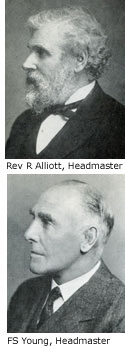 It's interesting to note that for the first one hundred years of its existence the school had only five headmasters: R Alliott 1869-1899; F S Young 1900-1931; H L Price 1932-1943; A N Evans (1944-1957; P W Rowe 1957-1968.
It's interesting to note that for the first one hundred years of its existence the school had only five headmasters: R Alliott 1869-1899; F S Young 1900-1931; H L Price 1932-1943; A N Evans (1944-1957; P W Rowe 1957-1968.
The original school buildings are still in use but many additions and new facilities have since been added. Architectural proof that the Establishment has always been forward thinking and unafraid to break with tradition is found in the Doggart Pavilion, built in the modern style in 1933, and in the octagonal shape glass structured dining hall built at Maze Green Road in 1962 – a truly radical departure but in keeping with the period.
The most recent developments to take the college firmly into the new millennium were the building of a £2.3m swimming pool, opened in October 2002, and the Ferguson Building, completed in June 2006. The latter, facing onto Maze Green Road and built on the site of a former maintenance yard, was named in memory of Professor John Ferguson, an eminent former pupil. This building was the winner of the town's civic federation's *Currey Award for best new building in Bishop's Stortford, 2006.
*The Currey Award was established in 1974 by Professor Harry Currey in memory of his first wife, Chrystal, secretary to the former civic society, formed in 1965. When Professor Currey died in 1998, his widow, Jacqueline, took over the presidency.
The College was always a Boys school, but in 1978 the first girls were admitted and its transition to full co-education began in 1995. In 2011 the school had in excess of 1100 pupils, over 500 of which were girls. And though it has always been primarily a boarding school it now takes in proportionally more day students. Nationally, the College's academic successes have gained it a very enviable reputation. Other recent developments have included purpose-built Pre-Prep accommodation for the 4-7 year olds (2005) and an impressive art centre for Senior School pupils (2009).
MORE PICTURES
|





 In 1866 a group of prominent Nonconformists in East Anglia formed a committee to establish a public school ‘in which Evangelical Nonconformists might secure for their boys an effective and Christian education on terms that should not be beyond the reach of the middle class generally’.
In 1866 a group of prominent Nonconformists in East Anglia formed a committee to establish a public school ‘in which Evangelical Nonconformists might secure for their boys an effective and Christian education on terms that should not be beyond the reach of the middle class generally’. In the First World War, 600 former students of the college served their country, sixty-two of whom made the supreme sacrifice. To their memory Mr Young instigated the building of the Memorial Hall in 1921/22, designed in a ‘Colonial’ Georgian style by architect, Clough Williams Ellis. At that time nobody could have dreamed it possible that the Roll of Honour at the hall's entrance would be joined by a second Roll of Honour in 1949, inscribed with the names of a further 154 former students who lost their lives in World War II.
In the First World War, 600 former students of the college served their country, sixty-two of whom made the supreme sacrifice. To their memory Mr Young instigated the building of the Memorial Hall in 1921/22, designed in a ‘Colonial’ Georgian style by architect, Clough Williams Ellis. At that time nobody could have dreamed it possible that the Roll of Honour at the hall's entrance would be joined by a second Roll of Honour in 1949, inscribed with the names of a further 154 former students who lost their lives in World War II. When Mr Young retired as headmaster in 1931 the reputation of the College had been well and truly established. Under him the number of entrants had risen to 350 and the Grammar school in Hadham Road, no longer able to compete, finally closed its doors and amalgamated with the college at around the same time as his retirement. He then took a curacy at Church Stretton in Shropshire but when ill health forced him to quit soon after, he returned to nearby Sawbridgeworth where he died on 2 September 1934. The library, built in 1932, was opened by his wife in 1936 and named the Young Memorial Library.
When Mr Young retired as headmaster in 1931 the reputation of the College had been well and truly established. Under him the number of entrants had risen to 350 and the Grammar school in Hadham Road, no longer able to compete, finally closed its doors and amalgamated with the college at around the same time as his retirement. He then took a curacy at Church Stretton in Shropshire but when ill health forced him to quit soon after, he returned to nearby Sawbridgeworth where he died on 2 September 1934. The library, built in 1932, was opened by his wife in 1936 and named the Young Memorial Library. It's interesting to note that for the first one hundred years of its existence the school had only five headmasters: R Alliott 1869-1899; F S Young 1900-1931; H L Price 1932-1943; A N Evans (1944-1957; P W Rowe 1957-1968.
It's interesting to note that for the first one hundred years of its existence the school had only five headmasters: R Alliott 1869-1899; F S Young 1900-1931; H L Price 1932-1943; A N Evans (1944-1957; P W Rowe 1957-1968.